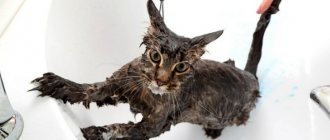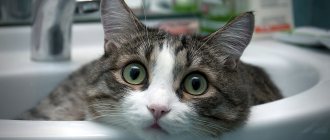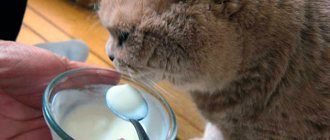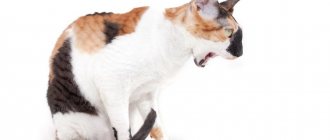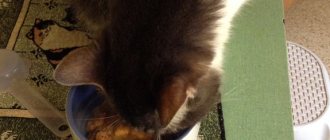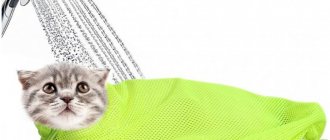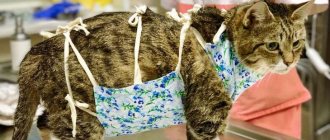An important step to maintain the beautiful appearance and health of the animal is drying the cat after the bathing procedure. It is a misconception that you cannot blow dry a cat. Wet wool in cold and drafts contributes to hypothermia, which ultimately leads to infectious diseases that make pets vulnerable. If from a young age the pet is accustomed to the noise from the operation of the device and a large air flow, then this procedure will save you from colds and the coat will become shiny and soft.
How to dry?
Drying occurs in 2 stages:
1. The animal’s fur is slightly dried on top with a strong stream of warm air.
2. Reduce the power of the hair dryer and dry the cat using a wide-toothed comb.
When drying, you must follow all safety precautions when working with electrical appliances:
Do not handle the hair dryer with wet hands; make sure that the wire is not damaged; feet should be dry; The cat should be seated on a rubber mat.
If all of the above conditions have been met, then drying a cat with a hairdryer will not cause unpleasant memories for either the animal or its owner.
By getting a four-legged friend, we take on great responsibility. If in natural conditions animals take care of themselves, then in domestic conditions the entire responsibility for appearance lies with the owner.
Cats themselves are very clean, but most often it is domestic cats that need to be bathed. If you accustom a cat to water procedures from childhood, then later she will get used to it and even enjoy it.
How to dry a cat after bathing? Will blow drying it harm it?
Many people believe that you should not blow-dry a cat - this can affect the fur and the animal’s psyche. This is a wrong opinion, but only if you have accustomed your cat to a hair dryer since childhood and it is not afraid of its noise and air flow. This procedure will protect your pet from colds, because... The wool itself takes a very long time to dry and, accordingly, cools.
Is it possible to dry it without it?
If you don’t have a household appliance, you can dry the cat using improvised means. A fan with an air heating function is well suited for this purpose. You need to place the animal close to such a device and wait for the fur to dry.
If such a device is also not in the house, the pet should be thoroughly dried with a towel and then placed near the radiator or in another warm place.
Blow drying is the easiest and safest way to remove moisture from your cat's fur. If desired, you can even train an adult animal to this procedure. The use of this device will protect your cat from colds and dermatitis.
How often can you wash your cat and at what temperature?
Has anyone ever wondered why cats are afraid of water? How justified is their fear? For animals, everything is much simpler; they are not subject to groundless panic. The fear of water in cats is due to the following:
- After swimming, they are at risk of hypothermia or overheating. The air cushion formed between the skin and fur of the cat warms it. After bathing, it disappears, the animal freezes. Also, the coat, naturally moistened with sebum, protects the cat from the scorching rays of the sun. A washed pet loses this protection.
- There is a risk of infection. The cat's sebaceous glands produce a secretion with antibacterial properties. During bathing, it is washed away, leaving the animal defenseless against bacteria, fungi, and other infections.
- Wet wool smells. Cats are by nature nocturnal animals and hunters. They have strong camouflage instincts. Purrs carefully bury feces behind them and carefully lick their fur coat so as not to emit odors. Washed cat fur smells very strongly, and this makes the cat very worried.
Therefore, you need to know how often to wash your cat. Veterinarians recommend:
- regularly once every 2-3 months, if the animal is healthy
- more often as needed and after consultation with a specialist
conclusions
So, by remembering these simple rules, you will turn bathing your pet into a pleasure for both of you.
Despite the fact that a cat is a clean animal and cleans its fur on its own, sometimes the pet still needs to take a bath. This happens after a walk on a rainy day - when the entire skin and paws become dirty and wet. In general, the cat needs to be washed regularly - about once a month. If this is not done at all, over time the wool may begin to emit an unpleasant odor.
To begin with, I would like to note that all cats are afraid of water and frantically try to get out of the bath when they are placed there. When planning to bathe a cat, be prepared for resistance on his part, especially if this is the first time. No cat would be happy to go into the water to enjoy a bath.
How to wash a cat at home
To wash your cat at home, you need to:
- prepare the necessary equipment;
- take water at a temperature of 39-40 C;
- dilute the detergent in a small container;
- place the pet in a basin or sink;
- moisten the fur with warm water;
- apply shampoo to wet fur;
- Using massaging movements, distribute the detergent over the pet’s body;
- rinse off the shampoo with plenty of water;
- place the cat in a towel and dry.
When is the procedure needed?
The need to bathe a cat arises in the following cases:
- The pet was picked up on the street or adopted from a shelter. As a rule, the usual hygiene procedure is followed by flea treatment.
- The animal got dirty. Cats, although they are clean creatures, can nevertheless, out of curiosity, become dirty by throwing over household garbage, paint, small litter, etc. on themselves.
- The cat often visits the street.
- During the molting period.
- The pet is about to have an exhibition.
The furry couch potato is usually washed when it gets dirty, but not more than 2 times a month.
Water temperature for washing cats
The optimal water temperature for washing cats should be comfortable for the pet - 39-40C. In cool water, the animal can freeze. Hot water will frighten your pet and negatively affect the condition of the coat.
Bathing equipment
To wash a cat you will need the following equipment:
- small plastic basin;
- a mat on the bottom of the container to prevent the cat’s paws from slipping;
- a jug or convenient container for clean water;
- two terry towels;
- hair dryer (if the cat is accustomed to blow drying).
What you will need to bathe a cat
You can also purchase a special net and even a cage for bathing obstinate pets at the pet store.
Popular mistakes
When washing a cat, inexperienced owners often make the following mistakes:
- ignore the preparatory stage and immediately place the pet in the water;
- use detergents not intended for animals;
- bathe a small kitten in a large bath;
- I act independently without the support of an assistant;
- do not comply with the temperature regime.
Watch this video on how to wash a cat:
Special devices
Nowadays there are many hair dryers on sale that are designed for drying animal hair. Such devices are equipped with a temperature regulator and come with a set of attachments that make the procedure easier. In addition, such devices make almost no noise. The following models are especially popular among cat breeders:
- Metrovac Air Force Commander.
- Tenberg Sirius Pro.
- XPOWER B-4.
- KOMONDOR F-01.
- DIMI LT-1090.
- Codos CP-200.
- LAN TUN LT-1090, etc.
Is it possible to dry a cat with a hairdryer after bathing and how to do it correctly?
An important step to maintain the beautiful appearance and health of the animal is drying the cat after the bathing procedure. It is a misconception that you cannot blow dry a cat.
Wet wool in cold and drafts contributes to hypothermia, which ultimately leads to infectious diseases that make pets vulnerable.
If from a young age the pet is accustomed to the noise from the operation of the device and a large air flow, then this procedure will save you from colds and the coat will become shiny and soft.
Is it possible to dry a cat with a hairdryer?
The main tool to quickly dry a kitten is a hairdryer.
You can and should dry your cat after bathing, but it is important to follow specific rules and recommendations. So, you can’t bring the device close to the animal’s skin, you need to keep it at a short distance
And also use a hairdryer at medium temperature and under a small air flow. If the cat is afraid of the sounds that are made, it is recommended to buy a hair dryer with a quieter operation or use a heater-wind blower. It can be brought to a wet pet, directing warm air to the right place.
This unit is almost silent and dries the skin faster.
What not to do?
- Leave the animal alone with the hairdryer running.
- Allow wet cats to come near electrical outlets.
- Without drying the pet, release it half wet.
- Screaming while drying.
- When drying yourself, keep the animal in a wet towel for a long time.
- Leave it to dry on its own, especially during the cold season.
- After the procedure, leave outside or in drafts for 24 hours.
How to properly dry a cat with a hairdryer?
The device must have a multi-stage power regulator.
For effective drying, you will need a hair dryer, a brush for combing the wool and the patience of the owner. It is recommended to adhere to the following rules:
- Turn on the device at medium or minimum power with a small air flow.
- You need to dry the kitten from the head area, then the neck.
- Then the forelimbs are dried.
- Gradually you should move to the cat’s stomach, and then to the back.
- Finally, dry the pet’s hind legs and tail, and carefully pass a stream of air over the pads.
When drying and after the procedure, it is necessary to talk to the animal, stroke and praise. This way, the cat will feel more confident and less stressed.
Drying stages
Wipe the cat. After taking water procedures, it is recommended to wrap the animal in a warm cloth and quickly wipe the fur, then the cat shakes off the water on its own. Next, it is recommended to take a new dry towel and wrap it around your pet. It should be of such a size that the pet can fit completely inside it.
Let the cat go to a warm room. Before the washing procedure itself, it is recommended to think through and prepare a place where a wet cat can warm up and lick itself. You need to take your pet to a warm room and let it out. Combing. The next step is to comb the kittens' fur with a comb or brush. This will make the fur fluff up and dry faster.
Blow dry. You should turn on the device and hold it near the cat so that he gets used to the noise when working. After that, adjust the average air flow, the temperature comfortable for the animal’s skin and point it at the pet. He may begin to break free; to do this, you should carefully hold him by the paws or withers.
After a few minutes, the cat itself realizes that the hair dryer is a source of heat and will calm down. It is important not to point the device at the ears and muzzle, so as not to cause discomfort. It is recommended to continue brushing the coat while drying.
It is necessary to scratch the cat with the growth of hairs and against them in order to dry the undercoat.
Praise the cat. An important point in the entire process. Thus, the animal will develop a reflex that the procedure of taking a bath and drying it with a hairdryer ends with pleasant moments, affection and tenderness from its owner. In subsequent times, these processes will be easier and faster for the owner and pet.
Conclusion
Blow drying your pet after bathing can be a fun and enjoyable experience for everyone involved.
The owner's task is to strictly adhere to the basic rules and recommendations for caring for his own pet. It is also necessary to show maximum calm, patience, not raise your voice and not hurt the cat.
Then the animal will not experience stress and may love the procedure of washing and drying with a hairdryer.
How to prepare to wash your cat
Before swimming, prepare all the items that may be useful to you during the process. As a soap, you need to use special shampoos for cats. Regular human shampoos will not work because their composition can damage the cat's soft fur and make it coarse. In addition, human shampoo has a powerful fragrance that remains on the hair or coat for a long time. If a cat smells something foreign for a long time, its sense of smell will be affected, and the animal may lose its sense of smell. Therefore, it is better to buy a special shampoo at a veterinary pharmacy, but not for dogs, but specifically for cats. Some manufacturers add special components to the shampoo that protect the animal's fur from insects.
Many people wonder how to bathe a cat - in a basin or in an open bath. In fact, the cat experiences much more fear in large volumes - in a spacious, smooth bathtub, where there is nothing to grab onto with its claws. Therefore, it is best to bathe a cat in a basin. Plus, if you have an acrylic bathtub, your pet may scratch and damage the surface.
So, fill two basins with warm water. The water should be really warm and even a little cool. Remember that hot water is one of the main factors that can scare your pet. Pour a little water into one basin, 5-10 cm, to lower the animal into it. There is no need to draw a lot of water so as not to stress the cat. The second basin (or bucket) should be completely filled with water, from there we will draw water using a mug. Do not wash your cat under direct streams of water from the shower. A shower head that hisses, makes noise and produces jets of water with pressure can be perceived by a cat as a living creature - an enemy.
When bathing a cat, it is best to wear long sleeves to prevent the animal from scratching. Be sure to prepare an old towel, or better yet several. Leave the shampoo open on the edge of the bath to make it easier to use. Remove everything unnecessary from the sides of the bath - shampoos, soaps, razors, hair balms, washcloths. In the process, the cat may knock over the cleaning supplies.
How to bathe a cat for the first time?
The earlier the better!
Experts are confident that it is necessary to accustom a cat to the process of bathing the sooner, the better.
.
Firstly, this rule is true not only for bathing, but also for any learning process. And secondly, because as a cat ages, it can become more aggressive.
Gradual training
It is necessary to accustom a kitten to bathe gradually, interest it, attracting its attention. How to do it better:
- Fill a basin or other not very large container with water.
- The water should be warm and there should be very little of it.
- Place the basin in the place in your house that the kitten likes most (or near it).
- Put his favorite thing there (for example, a rubber ball), thereby attracting and interested the kitten.
- Place your pet in a container of water, giving him the opportunity to get used to the sensations.
And only after all the manipulations have been carried out, you can start swimming.
animal. If everything is done correctly, then, even though cats do not like to swim by nature, your water procedures will be at least painless for both of you.
Some experts, by the way, claim that you can teach a kitten to bathe by personal example.
. That is, to show that it is not at all scary, but very pleasant and interesting.
Pros and cons of this drying method
There is an opinion that drying an animal with a hairdryer will lead to a deterioration in the condition of the coat and even the development of dermatitis. However, this is not true. If you select the correct mode of operation of the device, drying does not harm your pet.
At the same time, for some cats, being near the device can be extremely stressful. There is evidence that some individuals refuse food and behave restlessly for several days after the procedure.
Similar reactions are more often observed in old and particularly timid animals. After several procedures, the pet will get used to them.
Using a hair dryer for drying is not only possible, but also necessary. If the fur remains wet for a long time, the cat is highly likely to become hypothermic. This can lead to decreased immunity, colds and dermatitis. Thus, to quickly dry your pet's fur, you need a hairdryer.
The device must be used correctly. It should be set to low or medium operation so that the air does not get too hot. It is not recommended to bring the device too close to the animal’s body, because exposure to heat may cause discomfort in your pet.
Adult cat's first bath
The cat needs to get comfortable in the bathroom
There may be situations when you have to accustom an adult animal
. For example, if you adopted an adult cat who previously lived on the street.
As always, the main thing is your love, patience and self-control
. In principle, the process of accustoming and bathing itself is not much different from the usual one. It just might take a little longer. And you can get acquainted with the procedure and the environment in a dry bath. And even if your pet runs away, you shouldn’t despair. Everything will work out, it just takes a little more time and patience.
One of the important factors for creating favorable conditions for bathing your pet is lighting in the bathroom.
. Insufficient lighting can be another cause of stress in an animal.
How to make friends with a cat and a hairdryer?
The most effective will be the presence of a hairdryer in the life of a new pet from infancy. This does not mean that you need to bathe him every day. It will be enough to periodically turn on the hair dryer at minimum power in the presence of the animal, sometimes closer, sometimes further from it. If the cat’s reaction is positive, it is imperative that you praise it, stroke it, give it a treat and demonstrate sincere joy with your whole appearance.
This is very important, since animals are very sensitive and easily determine the mood of the owner. A pleasant atmosphere will eradicate the cat's fear of a hair dryer
If the situation is complicated by severe trembling, meowing and other negative indicators of the cat’s condition, you should not immediately turn off the hair dryer. Thus, the animal may develop a misunderstanding of what is happening and the reflex of demonstrating hysteria to stop unwanted actions will be reinforced. In such a situation, you need to remember who is the owner and persistently, but with understanding and love for the animal, continue to take steps to accustom the cat to the hair dryer.
In adult cats and cats, the period of getting used to the hair dryer should be carried out in exactly the same way, only you need to be prepared for the fact that it will take longer.
Scottish cat voice
Space backpacks for cats
Test passed. "Murkotiki" is recommended, but with a reservation regarding the size of the pet. The product is perfect for cats leading an active lifestyle.
Paw for combing animal hair
Test passed. "Murkotiki" recommend. This is one of the most effective and safe methods of combing cats and dogs.
Space backpacks for cats
Test passed. "Murkotiki" is recommended, but with a reservation regarding the size of the pet. The product is perfect for cats leading an active lifestyle.
Paw for combing animal hair
Test passed. "Murkotiki" recommend. This is one of the most effective and safe methods of combing cats and dogs.
We have to dry the cat -
thanks a lot!
How to dry a cat after bathing
Step #1. Drying the cat
Immediately after bathing, the cat needs to be carefully wiped down, without, of course, giving her a concussion. It’s better not to even wipe, but to get wet. And let her shake herself off, which is also quite effective.
After the cat has shaken itself off and you have thoroughly blotted it, take another towel and wrap it in it. The size should be chosen so that the cat fits entirely into the fabric.
It is desirable that the towels are terry, soft, and environmentally friendly.
Step #2. Let's go into the warmth
Before bathing, you should think about where you will dry the cat. We take the cat there while he is still in the towel. We put it in a towel on our hands or, for example, on a table or on a sofa.
Step #3. Drying
Turn on the hairdryer and place it nearby: let the cat get used to the noise. At first, the cat will be afraid of the hair dryer, but there is no need to follow the animal’s lead and immediately turn off the noisy device as soon as the cat starts screaming or shaking. Let him understand that such behavior does not lead to the desired result. And after a few minutes, when the animal realizes that the hairdryer is the source of heat that he now so needs, he himself will not want it to be turned off.
There is no need to direct the air flow directly to the face: the cat will consider this a threat. It is better to direct the air from the side, above or behind.
While drying, the cat needs to be combed. But not immediately, but as soon as the wool dries at least a little. If the fur is long and very tangled, you can purchase special conditioners at the pet store that help prevent it from tangling.
You need to scratch the cat both in the direction of hair growth and against the hair in order to dry the inner layer. Otherwise, the cat will be dry on the outside, and a wet layer will form under the fur - and the animal may get sick.
You can comb your cat with a regular comb with fine plastic teeth, or you can use a special paw, which is the most effective tool designed specifically for cats.
Step #4. We encourage
After the procedure, give the cat a treat. Then the cat will develop a reflex that bathing and drying ends pleasantly for him, and next time he will not react so sharply to the event.
The author of the article, Ekaterina Yugosh, is the editor of the Murkotiki website, a journalist with a felinological education (a felinologist is a specialist who studies cats). She received her felinological education according to the WCF (World Cat Federation) system. She raises a Scottish Straight cat and a Highland Fold cat, as well as a Miniature Schnauzer dog. Her areas of in-depth interests include zoodietology and zoopsychology.
A few rules for proper blow drying
1. The device must be turned on in advance. Let the cat get used to its noise.
2. First, the wool is slightly dried using hygroscopic towels.
3. The animal’s paws should not slip. It is best to sit him on your lap or spread a rug.
4. To make combing easier, you need to use special products for animal hair. This could be an antistatic spray or a liquid to prevent tangles from forming.
5. There is no need to direct a direct stream of air into the cat’s nose. He will perceive this as a direct threat to his life and will try with all his might to get out.
The structure of the psyche and the health of cats
The irrefutable fact is that the vast majority of cats do not like water.
, and with it the process of bathing. This is due to the fact that they are by nature more inclined to observe what is happening than to make direct contact. In addition, cats are generally self-contained and being forced to interact with humans repels them.
To top it all off, cats don’t understand the need to wash themselves, as they can clean themselves perfectly well. In this matter, much depends both on the mood of the animal and its owner, and on the cat’s health. You need to learn to choose the moment when bathing will not cause so many negative emotions and will not harm your pet’s psyche in any way.
Do not forget that after bathing, your pet should not be left wet. Cats differ in their health status, but no matter how strong it is, it’s not worth the risk. A wet animal can easily catch a cold by running or even just lying in a draft
This can also lead to hypothermia and, what is important for owners, wet wool has a stronger odor, is prone to tangling, the formation of pellets and, of course, debris sticks to it
In this regard, it becomes obvious that the cat is not afraid of bathing, but of the trouble it causes her. If you have already decided to give your pet a bath, be sure to warm it up and dry it afterwards, preferably with a hairdryer.
And here the next point appears, related to the fact that cats are afraid of loud sounds and noise. Most often, this is due only to the suddenness of the appearance of such stimuli or the animal’s perception of them as precursors of something bad. All these experiences cause fear in the cat and a desire to hide.
It is important to note that each cat has a different character and therefore they do not calm down equally quickly after a stressful situation. In general, the main task of the owner is the need to protect the pet from severe shock
Add a comment
A very insidious and dangerous disease is panleukopenia.
The most vulnerable are kittens 3-6 months old. Up to 3 months, the milk of mother cats very effectively protects against all diseases. After 3 months, kittens are at risk. At the first symptoms - vomiting, diarrhea
My cat eats melon
There are millions of sites about cats on the Internet, but there are no sites about Scottish and British cats that would provide maximum information on the breed. The website murkotiki.com aims to fill this gap. Here you will find essays about the personal experiences of the authors, advice from veterinarians, felinologists and zoopsychologists. Our mission is to ensure that there are more healthy and happy cats in the world that delight their owners.
Data on the treatment of diseases are provided for informational purposes. Site visitors should not use them as medical advice. Consult a veterinarian who has personally examined the animal. The company is not responsible for possible negative consequences resulting from using the information posted on the site without consulting a veterinarian.
Data on animal reproduction is also provided for informational purposes only, and not as a guide to action. The site cannot replace the felinological education necessary for organizing a nursery. Read other rules for using the site.
The site contains contextual advertising from Google and Yandex, which use cookies. The editors are not responsible for the content of advertising materials of these systems.
Rules for drying a cat with a hairdryer
The entire drying period can be divided into several stages:
- First you need to lightly dry the animal from above with a powerful stream of air.
- At a lower power of the hairdryer, using a comb, you should thoroughly dry the entire body of the animal against the hair, slightly pulling out the fur.
- The cat should be dried starting from the hind legs, when the animal lies on its back. All movements should be smooth and slow enough so as not to frighten the pet. You can hire someone to help you pet the animal.
If you are not lazy and spend a little time preparing your cat for bathing and then drying the fur with a hairdryer, then the whole procedure will be painless for both the animal and its owner.
Cleanliness is the key to health. If not all of us, then many have heard this phrase. And this is absolutely true. Indeed, if basic rules and standards of hygiene are not observed, the body is much more susceptible to various diseases. This applies to both us and our pets.
Therefore, it is very important to keep your cat clean and not forget about things like brushing, trimming claws, bathing, etc. Even though a cat is a very clean animal, it is necessary to bathe it for preventive purposes!
Even though a cat is a very clean animal, it is necessary to bathe it for preventive purposes!
On the one hand, the conclusion is completely obvious - of course it is necessary! After all, hygiene is so important. But if you think about it, not everything is so simple
After all, firstly, cats often and thoroughly wash themselves. Secondly, it’s okay if the cat periodically goes outside and she can’t wash off all the dirt herself. What if the animal is always at home? What to do then?
The answer to such questions is clear - you need to bathe
. An animal is not able to cope with all pollution on its own. The only difference is that a cat that is constantly kept in an apartment needs to be washed somewhat less frequently than one that is kept outside.
How to bathe a cat if she is afraid of water, resists and scratches?
It is extremely rare to find a cat that does not resist being bathed. They may meow loudly, try to escape, and use any other means to prevent or stop bathing.
. And this is, in general, a normal natural reaction. But you still need to bathe.
No violence!
In order for bathing to go smoothly, you need to understand that this is quite stressful for a cat and you must be extremely patient. You also need to remember the algorithm for proper bathing. By doing everything correctly, you will reduce bathing time and your and your cat’s nerves to the required minimum.
First you need to take care of the wool
Insert cotton swabs into your ears to prevent water from getting in. We first remove all potentially dangerous objects or anything that could break from the bathroom.
We remove all foreign objects
If necessary, dilute the shampoo. We collect water: the level is up to the cat’s belly, the temperature is no more than thirty-seven degrees. Be sure to place a mat or something else at the bottom of the bath to prevent slipping. We put the animal in the bath, keeping calm and confident. Using a ladle, watering can or other container convenient for you, carefully water the cat, carefully holding it.
You can water from the shower. But watch the pressure. The loud sound of water can scare a cat
Then apply detergent, foam, leave for a couple of minutes.
Apply shampoo to the cat and wait a couple of minutes
Then you can wash it off. If necessary, apply shampoo again. If there is no such need, then apply it and then rinse thoroughly. Take the cat out and wrap it in a large warm towel.
Wrap the cat in a towel
You must be calm, patient and friendly. Otherwise, you risk not only turning bathing into a chore forever, but also causing your pet to experience extreme stress!
Is it possible to blow dry a cat after bathing?
There is no need to dry your cat with a hairdryer after bathing.
And you also need to know that if the room is hot or warm, then you don’t need to dry the cat with a hairdryer
. There is no need for this, but there will be additional stress from noise. But you should also not dry the animal with a towel. It is enough to wait until all the excess moisture from the wool is absorbed.
Can I bathe my cat with regular shampoo?
Cats, like other animals, need to be bathed only with special shampoos.
What to bathe with
your pet? Is it possible to use “human” shampoos? And is shampoo alone enough?
All these are important questions, the answers to which every owner who loves and cares for their cat should know.
Nowadays there is a very wide range of products for bathing cats. Therefore, you can easily choose exactly what is right for you and in your specific situation.
Shampoo alone
- this is what experts say. Still, it is better to use a special conditioner after shampoo. You also need to know that, almost always, shampoos are concentrated and are used only after dilution with water.
Dry shampoos and conditioners
do not give the desired result, and they can only be used in extreme cases.
Contraindications for bathing cats
Despite the need for regular water procedures, there are a number of situations when bathing should be carried out with the utmost care
or should be postponed until better times.
It should be borne in mind that if a cat is not accustomed to washing from early childhood, the bath will become extremely stressful for him. You should start accustoming your kitten to a bath 3 weeks after he has settled in his new home.
.
Since such a stressful situation puts a strain on the heart, it is not recommended to wash elderly animals
.
Contraindications to
water procedures for cats are:
- Late pregnancy.
- In the early stages of pregnancy, a cat can be bathed very carefully and only when absolutely necessary.
- The period of feeding kittens with milk. The stress of bathing can contribute to the disappearance of milk in the female.
- Severe acute and chronic diseases.
- Recently undergone surgery.
- The temperature in the apartment or house is below 22 degrees.
Bathing a cat is not the longest process, but it can cause many difficulties. In this case, it is strongly recommended to be patient and talk to the animal in a gentle, soothing tone. Over time, your pet will begin to perceive hygiene procedures more calmly and will not leave a large number of scratches and abrasions on your hands.
Does bathing a cat feel like torture? Find out how to carry out the procedure painlessly for the pet and its owners.
Even those who have never kept them at home are well aware of the relationship of cats to water. Purrs can't stand her and everything connected with her! And if there is a need to buy a cat, both the pet and its owner receive stress from the procedure, which often resembles an execution.
This happens because bathing rules are not followed and it happens in a hurry. Below are some tips that, if you listen to them, will not turn the bath into your cat’s favorite pastime, but will at least make it tolerable and harmless.
Is it possible to bathe a pregnant pet?
Before performing the bathing procedure, it is worth learning about other methods of care that are most suitable for a cat in this situation. You can visit a veterinarian with your cat, he will examine the animal and be able to clean the fur from fleas and parasites, if any. Thus, the risk of harm to the fetus is minimized. You can get advice from your veterinarian about safe grooming methods. If the cat is already accustomed to water procedures and the aromas of detergents, then bathing is allowed. If there are negative associations and emotions with water, it is necessary to wash the fur as carefully as possible, without sudden movements, and do not forcefully hold it by the withers, causing pain.
When bathing, it is recommended to follow specific tips that will facilitate this process:
- The temperature should be comfortable for the pet. You should carefully ensure that the water is warm, and in no case hot or cold, as temperature changes can cause miscarriage or a cold.
- If there is no severe contamination throughout the body, for example, if only the paws are dirty, it is not recommended to bathe the cat completely; it is enough to wash only the pads and fur on the paws.
- It is not recommended to wash your cat with shampoo unless absolutely necessary. If you have fleas and parasites, the right solution would be to purchase skin capsules or a specialized collar. You can use dry shampoo, which does not require water to work.
Why is it not advisable to swim?
If bathing is very stressful for your pet, then it is better to postpone the procedure and do it only in case of severe contamination.
Cats require special care for their coat during pregnancy. When an animal licks itself, it can swallow the remains of detergents with saliva. Taking water procedures is a strong stress for the pet, which will not bring benefits for her and future offspring. But there are situations when bathing cannot be avoided: accumulated dirt and dust on the coat after walks, or if parasites have appeared.
You can bathe your pet only when using other hygiene products is pointless, and you should take into account the health status of the pet and its general well-being. It is not recommended to take water procedures for those whose pregnancy proceeds with complications, and in the first weeks, as this is a strong stress
